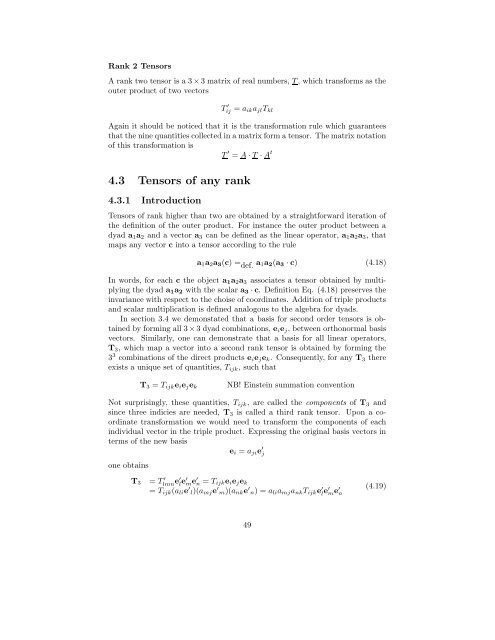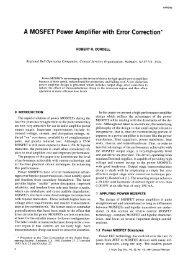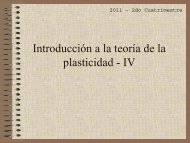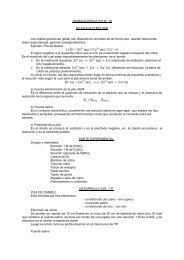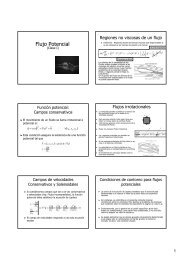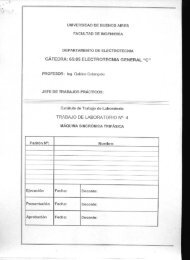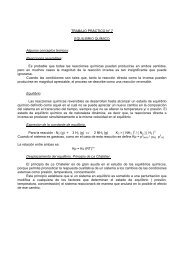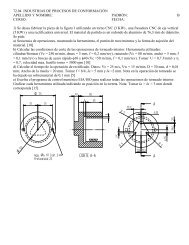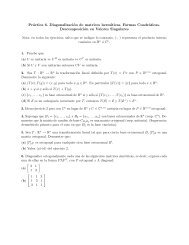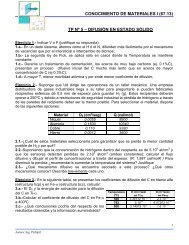Introduction to vector and tensor analysis
Introduction to vector and tensor analysis
Introduction to vector and tensor analysis
You also want an ePaper? Increase the reach of your titles
YUMPU automatically turns print PDFs into web optimized ePapers that Google loves.
Rank 2 Tensors<br />
A rank two <strong>tensor</strong> is a 3 × 3 matrix of real numbers, T , which transforms as the<br />
outer product of two vec<strong>to</strong>rs<br />
T ′<br />
ij = aikajlTkl<br />
Again it should be noticed that it is the transformation rule which guarantees<br />
that the nine quantities collected in a matrix form a <strong>tensor</strong>. The matrix notation<br />
of this transformation is<br />
T ′ = A · T · A t<br />
4.3 Tensors of any rank<br />
4.3.1 <strong>Introduction</strong><br />
Tensors of rank higher than two are obtained by a straightforward iteration of<br />
the definition of the outer product. For instance the outer product between a<br />
dyad a1a2 <strong>and</strong> a vec<strong>to</strong>r a3 can be defined as the linear opera<strong>to</strong>r, a1a2a3, that<br />
maps any vec<strong>to</strong>r c in<strong>to</strong> a <strong>tensor</strong> according <strong>to</strong> the rule<br />
a1a2a3(c) = def. a1a2(a3 · c) (4.18)<br />
In words, for each c the object a1a2a3 associates a <strong>tensor</strong> obtained by multiplying<br />
the dyad a1a2 with the scalar a3 · c. Definition Eq. (4.18) preserves the<br />
invariance with respect <strong>to</strong> the choise of coordinates. Addition of triple products<br />
<strong>and</strong> scalar multiplication is defined analogous <strong>to</strong> the algebra for dyads.<br />
In section 3.4 we demonstated that a basis for second order <strong>tensor</strong>s is obtained<br />
by forming all 3 × 3 dyad combinations, eiej, between orthonormal basis<br />
vec<strong>to</strong>rs. Similarly, one can demonstrate that a basis for all linear opera<strong>to</strong>rs,<br />
T3, which map a vec<strong>to</strong>r in<strong>to</strong> a second rank <strong>tensor</strong> is obtained by forming the<br />
3 3 combinations of the direct products eiejek. Consequently, for any T3 there<br />
exists a unique set of quantities, Tijk, such that<br />
T3 = Tijkeiejek<br />
NB! Einstein summation convention<br />
Not surprisingly, these quantities, Tijk, are called the components of T3 <strong>and</strong><br />
since three indicies are needed, T3 is called a third rank <strong>tensor</strong>. Upon a coordinate<br />
transformation we would need <strong>to</strong> transform the components of each<br />
individual vec<strong>to</strong>r in the triple product. Expressing the original basis vec<strong>to</strong>rs in<br />
terms of the new basis<br />
one obtains<br />
T3 = T ′<br />
lmne′ le′ me′ n<br />
ei = ajie ′ j<br />
= Tijkeiejek<br />
= Tijk(alie ′ l)(amje ′ m)(anke ′ n) = aliamjankTijke ′ le′ me ′ n<br />
49<br />
(4.19)


